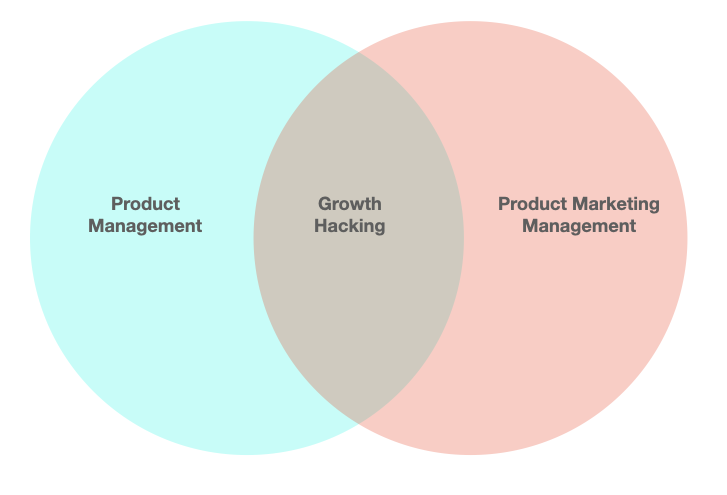#005: Product Management And Product Marketing
Or PM and PMM (a.k.a. product marketing management)
Two very common misconceptions that can be observed in startup land as well as in corporate land are best expressed by the following statements:
We build the product and because it will be so insanely good it will - somewhat magically - grow organically until we are profitable (typically the startup case).
We build the product and then through marketing - also somewhat magically - it will grow until we are profitable.
Today most software products - especially B2C a.k.a. software consumer products but also B2B or B2B2C products such as many SaaS - need to have some marketing features embedded into the product itself in order to grow.
Marketing and product management are no longer two separate entities.
There is a big overlap area between these two topics which can generally be described as “growth hacking“.
Growth hacking is the process of figuring out - as quickly as possible - what works and what does not.
When building a product PMs have to take lots of decisions based on assumptions and incomplete information.
Then, when launching a product, PMs can only “hope” that a significant portion of those assumptions weren’t completely wrong.
That’s the moment when PMMs jump in and growth hacking starts.
And be prepared: some of the learnings can be pretty unintuitive as you can see from the examples below.
Example: Airbnb
While still being in their early days, Airbnb noticed that listings with high-quality pictures performed better on their website than those with messy pictures (or pictures of messy apartments, which are actually two sides of the same coin).
Airbnb then decided to offer to their hosts to take professional pictures from their apartments.
This was an expensive move (and an alternative could have been to try to teach their hosts to take better pictures themselves).
Yet, it highly paid off as you can see in the growth curve below.
This photo-feature is a combination of product management and product marketing since the placement, engagement and UX is PM but its outcome is marketing-driven.

Example: Uber and Amazon
We all remember when the Facebook-login option appeared on the Uber-app.
Its singular purpose was to increase time-to-value for the user by removing friction during the sign-up process, which in turn should drive conversion during the onboarding process of new users, hence, drive growth.
Similarly, one of Amazon’s most notorious growth hacks was their introduction of the “Buy now with 1-Click“-button.
Again, the sole purpose of it was to remove friction during the check-out process.
In both examples, PMs were involved to deliver those features yet the decision and specification was orchestrated with PMMs.

Example: Wall Monkeys
A classical tool for both PMMs and PMs is A/B testig, where, for instance, a web-app or website runs two different versions simultaneously.
Then engagement can be measured and compared.
Below is a well-known growth hack delivered by Wall Monkeys where they discovered that by replacing the search bar by a “SHOP NOW“-CTA-Button conversion could be increased by 550%.
This was obviously not a design or UX decision but a growth hack, which to be implemented then required design, UX and PM.
Example: Sim City (Video game)
When Electronic Arts promoted SimCity, one of their great classic video games, they incentivized website visitors with a $20 voucher which gamers could redeem upon their next purchase.
However, when they removed the voucher sales spiked by 40% (!!?)
It turned out that gamers who want to purchase a specific video game do not care about the next game to purchase.
In fact, you should not distract them with other video games’ promotions during the purchasing experience or you will literally pay for it.
Example: Hotmail
Those among us who are old enough still remember hotmail (see title image of this article on top).
Hotmail is (unofficially) credited with having applied the first growth hack in history of digital products.
In fact, in 1996, a few months after their launch which took place in July that year, they experienced a flattening in their growth curve.
Without having a large marketing budget they decided to add a small text line to the footer of each of their sent emails saying
”PS: I love you. Get your free e-mail at Hotmail”
which linked to the sign-up page of Hotmail.
Thus, every user became a sales person for Hotmail and viral growth immediately kicked in.
The moral of this post:
Don’t think somebody can build the product and then someone else will market it and then growth kicks in.
Great products can only be built by great teams.
If you’d like to learn more, there are 3 ways I can help you:
Subscribe to this newsletter if you want to get actionable tips on software product management.
Email me at danielschmitter@substack.com to provide suggestions about blog topics.
Follow or connect with me on LinkedIn here.







Great post. You have a lot of great external customer examples. Internal marketing is also so huge. Adoption (unless your users have no choice) can be overlooked and should definitely be at top of mind when you’re shipping the internal products.